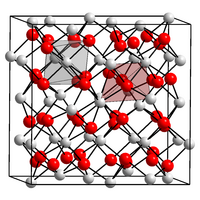Lutetium (III) oxide
| Crystal structure | ||||||||||||||||
|---|---|---|---|---|---|---|---|---|---|---|---|---|---|---|---|---|

|
||||||||||||||||
| __ Lu 3+ __ O 2− | ||||||||||||||||
| General | ||||||||||||||||
| Surname | Lutetium (III) oxide | |||||||||||||||
| other names |
|
|||||||||||||||
| Ratio formula | Lu 2 O 3 | |||||||||||||||
| Brief description |
White dust |
|||||||||||||||
| External identifiers / databases | ||||||||||||||||
|
||||||||||||||||
| properties | ||||||||||||||||
| Molar mass | 397.93 g mol −1 | |||||||||||||||
| Physical state |
firmly |
|||||||||||||||
| density |
9.42 g cm −3 |
|||||||||||||||
| Melting point |
2487 ° C |
|||||||||||||||
| boiling point |
3980 ° C |
|||||||||||||||
| solubility |
|
|||||||||||||||
| Refractive index |
1.94743 |
|||||||||||||||
| safety instructions | ||||||||||||||||
|
||||||||||||||||
| As far as possible and customary, SI units are used. Unless otherwise noted, the data given apply to standard conditions . Refractive index: Na-D line , 20 ° C | ||||||||||||||||
Lutetium (III) oxide is a chemical compound from the group of oxides .
Occurrence
Lutetium (III) oxide occurs naturally to a very small extent (0.003%) in the mineral monazite .
Extraction and presentation
Lutetium (III) oxide can be obtained by burning lutetium with oxygen (air) or, most simply, by thermal decomposition of lutetium oxalate.
The world production of lutetium in the form of lutetium (III) oxide is about 10 tons per year.
Lutetium (III) oxide nanocrystals can be obtained by reacting lutetium nitrate with urea .
properties
Lutetium (III) oxide is a white powder that is insoluble in water. It is hygroscopic and also absorbs carbon dioxide . It reacts with acids to form cations , which in turn react weakly acidic in water. Like the other trivalent oxides of the heavier lanthanoids, it crystallizes in the cubic lanthanoid-C structure with a = 1039 pm and Z = 16. It has a high absorption coefficient for X-rays , which makes it interesting as a scintillation material for medical detectors.
use
Lutetium (III) oxide is used in the manufacture of special glasses and also as a catalyst in cracking, for alkylation, hydrogenation and polymerization. It also serves as a raw material for the production of laser materials . A compound of lutetium (III) oxide and palladium (II) oxide (generated at high pressure and temperature in the presence of potassium chlorate ) has properties that are of interest for superconducting materials.
Individual evidence
- ↑ a b c d e f data sheet Lutetium (III) oxide, 99.99% trace metals basis from Sigma-Aldrich , accessed on March 11, 2012 ( PDF ).
- ↑ a b c d e Reade: Lutetium Oxide Powder (Lu 2 O 3 ) ( Memento of the original dated May 6, 2012 in the Internet Archive ) Info: The archive link was inserted automatically and has not yet been checked. Please check the original and archive link according to the instructions and then remove this notice.
- ↑ O. Medenbach et al .: Refractive index and optical dispersion of rare earth oxides using a small-prism technique , J. Opt. A: Pure Appl. Opt. 3, pp. 174-177, 2001 doi : 10.1088 / 1464-4258 / 3/3/303 .
- ^ A b John Emsley: Nature's building blocks: an AZ guide to the elements . Oxford University Press, 2003, ISBN 978-0-19-850340-8 , pp. 300 ( limited preview in Google Book Search).
- ^ A b A. F. Holleman , E. Wiberg , N. Wiberg : Textbook of Inorganic Chemistry . 102nd edition. Walter de Gruyter, Berlin 2007, ISBN 978-3-11-017770-1 , pp. 1941-1943.
- ↑ E. Zych, W. Mielcarek, M. Kojdecki, K. Domagala: X-ray investigation of lutetium oxide nanostructured material . Applied crystallography: proceedings of the XVIII conference, 2001, ISBN 978-981-02-4613-6 , pp. 302 ( limited preview in Google Book search).
- ^ Robert E. Krebs: The history and use of our earth's chemical elements: a reference guide . Greenwood Pub Group, 2006, ISBN 978-0-313-33438-2 , pp. 304 ( limited preview in Google Book Search).
- ^ Periodic table online: lutetium (III) oxide
- ↑ Oliver T. Chang: Frontal semiconductor research . Nova Science Publishers, 2006, ISBN 978-1-60021-210-9 , pp. 7 ( limited preview in Google Book search).



